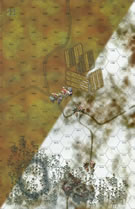|
Total |
| Side 1 |
0 |
| Draw |
0 |
| Side 2 |
0 |
|
Total |
| Side 1 |
0 |
| Draw |
0 |
| Side 2 |
0 |
|
Total |
| Side 1 |
0 |
| Draw |
0 |
| Side 2 |
0 |
| Overall Rating, 0 votes |
|---|
|
|
|
Scenario Rank:
--- of 913 |
| Parent Game |
Elsenborn Revised |
| Historicity |
Historical |
| Date |
1944-12-19 |
| Start Time |
02:30 |
| Turn Count |
16 |
| Visibility |
Night |
| Counters |
41 |
| Net Morale |
0 |
| Net Initiative |
0 |
| Maps |
1: 22 |
| Layout Dimensions |
43 x 28 cm
17 x 11 in |
| Play Bounty |
218 |
| AAR Bounty |
227 |
| Total Plays |
0 |
| Total AARs |
0 |
|
Introduction
|
|
Pulled out of the line after its failure at the twin villages, the Hitler Youth Division swung instead onto the road to the large farm known to the Americans as Dom Butgenbach. At first they found easier going over routes cleared by 1st SS Panzer Division, and then they ran head on into the U.S. 1st Infantry Division. The SS recon battalion blundered into the Big Red One on the afternoon of the 18th and was badly shot up; by the time the rest of the SS division was ready to attack in the wee hours of the next morning, the Americans were primed and ready for them. "We fight and die here," Lt. Col. Derril Daniel told his 2nd Battalion of the 26th Infantry Regiment, a phrase his men would repeat to each other constantly over the next several days.
|
|
Conclusion
|
|
The Hitler Youth formed up just outside of American sighting range and then began a wild assault on the manor. But having been bounced by a good American division, they now found themselves facing a great one. The Americans lit up the night with illumination rounds, and then poured artillery fire on the advancing Germans. Three German tank destroyers actually made it to the farm, but were driven off by artillery fire and the threat of American bazooka teams. The remnants of the German force drew off into the night, and once again the Hitler Youth would have to dig a grossly outnumbered force out of a crossroads village. Daniel remained highly confident: with a Ph.D. in entomology from Clemson University, he was a recognized expert in the eradication of vermin.
|
|
Additional Notes
|
|
This scenario is completely playable using the maps and pieces from Battle of the Bulge 2: Elsenborn Ridge.
SS transport counters are available as a free download from Avalanche Press. If not using these or other SS transport from other games, players should use regular German army transport as substitutes. |
Display Relevant AFV Rules
| AFV Rules Pertaining to this Scenario's Order of Battle |
- Vulnerable to results on the Assault Combat Chart (7.25, 7.63, ACC), and may be attacked by Anti-Tank fire (11.2, DFT). Anti-Tank fire only affects the individual unit fired upon (7.62, 11.0).
- AFV's are activated by tank leaders (3.2, 3.3, 5.42, 6.8).
They may also be activated as part of an initial activating stack, but if activated in this way would need a tank
leader in order to carry out combat movement.
- AFV's do not block Direct Fire (10.1).
- Full-strength AFV's with "armor efficiency" may make two anti-tank (AT) fire attacks per turn
(either in their action segment or during opportunity fire) if they have AT fire values of 0 or more
(11.2).
- Each unit with an AT fire value of 2 or more may fire at targets at a distance of between 100% and 150% of its
printed AT range. It does so at half its AT fire value. (11.3)
- Efficient and non-efficient AFV's may conduct two opportunity fires per turn if using direct fire
(7.44, 7.64).
Units with both Direct and AT Fire values may use either type of fire in the same turn as their opportunity fire,
but not both (7.22, 13.0).
Units which can take opportunity fire twice per turn do not have to target the same unit both times (13.0).
- Demoralized AFV's are not required to flee from units that do not have AT fire values (14.3).
- Place a Wreck marker when an AFV is eliminated in a bridge or town hex (16.3).
- AFV's do not benefit from Entrenchments (16.42).
- AFV's may Dig In (16.2).
- Closed-top AFV's: Immune to M, M1 and M2 results on Direct and Bombardment Fire Tables. Do not take step losses from Direct or Bombardment Fire. If X or #X result on Fire Table, make M morale check instead (7.25, 7.41, 7.61, BT, DFT).
- Closed-top AFV's: Provide the +1 modifier on the Assault Table when combined with infantry. (Modifier only applies to Germans in all scenarios; Soviet Guards in scenarios taking place after 1942; Polish, US and Commonwealth in scenarios taking place after 1943.) (ACC)
- Tank Destroyer: do not provide the +1 Assault bonus, even if closed-top (SB)
|
United States Order of Battle
| 1 Errata Item |

|
The reduced direct fire value of the SS HMG is 5-5 in Beyond Normandy and Road to Berlin.
|






 EbRR015
EbRR015 



















